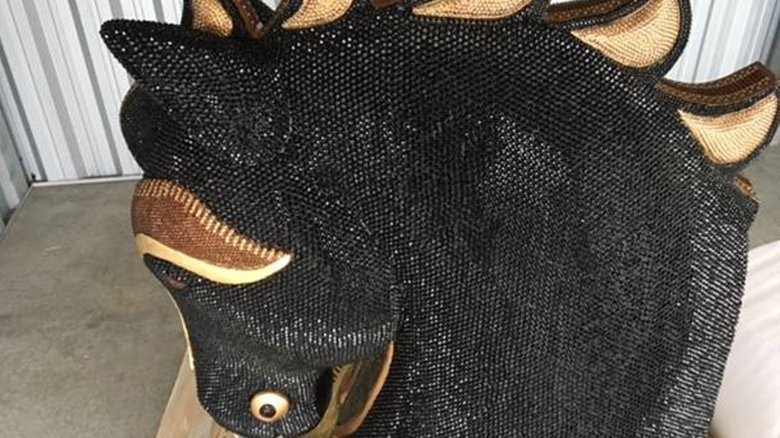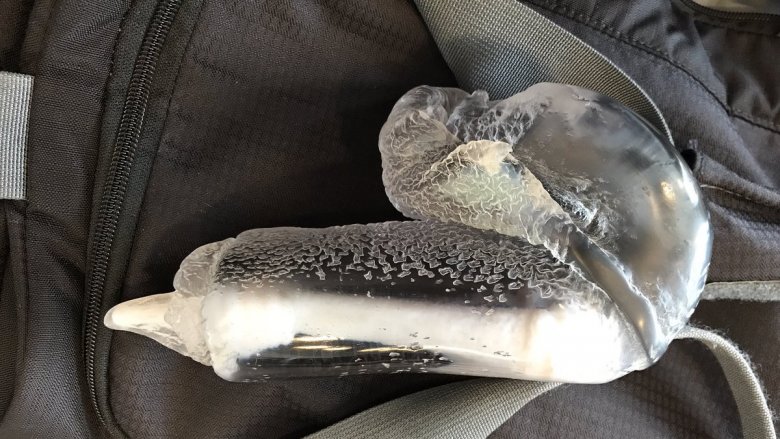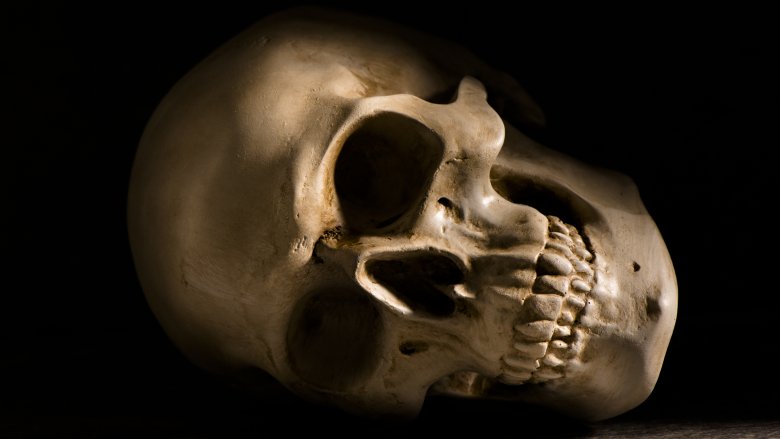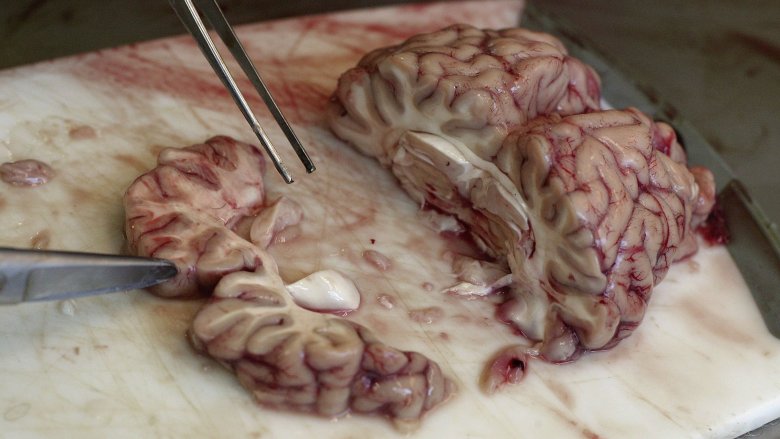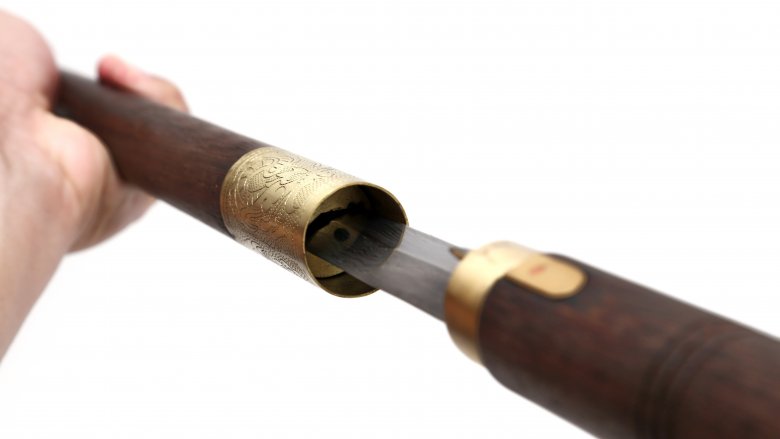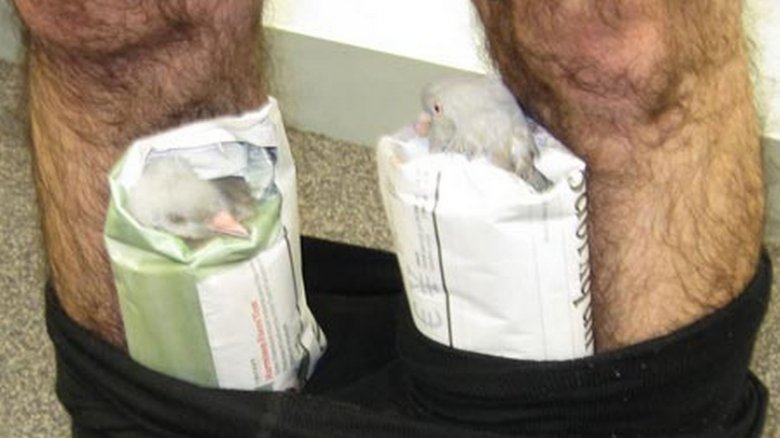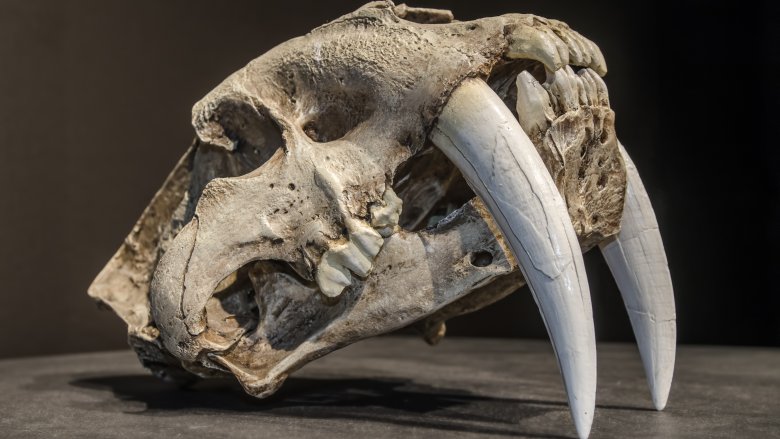The Most Bizarre Things Discovered By Airport Security
Airport security checks have a bad rap—and for good reason. They're basically a mishmash of unsolicited groping and x-ray fetishism. Throw in the TSA's penchant for hassling disabled children and you have a recipe for never-ending customer anguish. But in fairness, the passengers don't make it easy. Some have the hygiene of sewer rats while others respond to authority with literally naked defiance. But the biggest knock to the noggin undoubtedly comes from all the illicit items found during security checks—some of which defy all sanity and expectation. Be warned, one or two may also be NSFW.
A giant cocaine-filled horse head
If you want to move mountains of coke through an airport, you shouldn't wear a lemony pimp suit and fish tank shoes. Why? Because flamboyance gets you fried like a turkey while blandness will likely save your bacon. That's Drug Trafficking 101. But every system has its anomalies, and smuggling proves no exception. In 2016, for instance, a team of traffickers concealed cocaine in a ginormous black horse head.
Actually, "ginormous" doesn't do this thing justice. At 882 pounds (400 kg), the behemoth head weighed almost as much as an average stable horse. Exacerbating the absurdity, this literal coke head had a coat of obnoxiously fake jewels.
According to CNN that glittering monstrosity was somehow supposed to make it all the way from Mexico to New Zealand without rousing suspicion. Obviously, that didn't happen. Once the nearly half-ton head reached New Zealand's Auckland International Airport, customs officials emptied it like a piñata. Only instead of finding sweets, they uncovered $10 million worth of nose candy.
Customs had accomplished the largest coke bust in Kiwi history, but authorities were probably too busy laughing to care. Things quickly got serious when three men arrived to retrieve the head and received handcuffs instead. According to Stuff, a 12-person jury convicted two defendants for abject stupidity (among other crimes) but cleared the third. Sentencing was set for August 2017, provided the men didn't get teased to death first.
A 3D-printed mouse dong
Even the staunchest Luddite would likely agree that 3D printers have a lot going for them. They can make burgers and pizzas for Pete's sake. But both fortunately and unfortunately, these machines do more than promote obesity. On the positive side, you can use them to print toys and stylish knickknacks. On the grotesquely dark side, you can also generate animal privates. And no, that's not a hypothetical.
In 2017, The Atlantic recounted a pricelessly awkward exchange between University of Florida researcher Martin Cohn and authorities at Ronald Regan Airport. For context, Cohn studies tiddly bits in hopes one day helping people with malformed dongs and dongettes. Part of that work entails studying animals and 3D-printing their privates because science has a great sense of humor. A TSA member spotted one of these R-rated replicas—a giant copy of dude mouse junk—during a baggage scan.
According to Cohn, the intrigued officer "pulled out this mouse penis by its base, like it was Excalibur." He hadn't broken any rules, but the officer insisted on knowing what she'd just discovered. Cohn informed her she was holding six-inches of artificial mouse love, which visibly tickled her to no end. Excited, she invited coworkers to behold the rodent rod. Uproarious laughter followed, marking the first time a mouse club not belonging to Mickey brought joy and wonder to a group of people.
Human skulls
Psychological research on humans and animals suggests that superstitions derive from a fundamental need to remove uncertainty in potentially adverse situations. And it makes sense. If a clown walked by that one time you successfully asked someone out, you might insist on donning clown makeup on all your dates. Similarly, if you fear falling out of the sky or other unlucky events, you carry around parts of someone's head.
Apparently that's happened more than once at Florida airports. As per The Atlantic, in 2006 an unnamed woman committed the creepy crime of smuggling a skull from Haiti. Intended to thwart malevolent spirits, the skull ironically got its owner arrested. Seven years later a pair of women at Fort Lauderdale-Hollywood International got also got caught with cranial remains. In this case the travelers had purchased magic pots in Cuba, again to halt evil forces. Disturbingly, the pots contained chunks of human skull, teeth, and dirt. Honestly, that sounds pretty useless unless you're starting a bone garden.
Unlike the first example, police released the two women after questioning (which sounds kind of lucky). Meanwhile fellow passengers pondered what the heck they'd just witnessed. According to CBS, one baffled traveler wondered, "What do you do with a skull and teeth?" Obviously, you cry fearful tears.
Raw cow brains and other meaty madness
As a general rule, you should avoid getting confused with a budding serial killer when you enter or exit an airport. It makes people uneasy and draws unwanted attention. Thankfully, there exist some sure fire ways to mitigate misplaced murder associations. Firstly, leave all blood-stained clothing and torture devices at home. Secondly, stop looking so shifty-eyed. And lastly, refrain from storing dismembered limbs, organs, or severed heads (especially human skulls) in your luggage. These steps should seem reasonable. However, not everyone manages to follow all three.
One of the more recent failures occurred in February 2017 when a woman arriving in the U.S. from Vietnam got caught with assorted animal fragments. WFAA explained that the questionable traveler had declared to customs that her meat menagerie consisted of only dried an cured animal portions. However, a quick inspection revealed 22 pounds of raw brains, tongues, hearts, feet, and severed heads. This potential crime scene evidence came from cows, pigs, chickens, and hopefully no humans.
Despite looking like she'd murdered half a farm, the woman apparently didn't get in any serious trouble. But since customs officials couldn't just let potentially diseased meat pass into the U.S. they wisely disposed of it. Unsettlingly, this sort of thing happens regularly. According to Dallas Customs and Border Protection, the agency intercepts over 4,600 pounds of unapproved plant and animal bits annually. It's unclear how much of that is cow heads.
A freaking sword cane
Nothing screams "contraband" like an object capable of deboning, de-braining, or otherwise destroying the human anatomy. Even something the merely looks dangerous—like a grenade-shaped weed-grinder—can plunge an airport into panic. But appearances sometimes deceive. Some objects can shred you like mozzarella but look as harmless as your grandma at church. And sometimes your rickety grandma unknowingly owns one of those deadly doodads and tries to take it on a plane. In fact, that very thing happened in February 2017.
As reported by CBS and the Associated Press, an 80 year-old woman walked into Myrtle Beach International Airport looking about as threatening as a bag of cotton balls. She even had a cane to help her get around. However, x-rays revealed that that this innocuous octogenarian owned a sword cane. This came as an absolute shock...to the old lady. According to airport security, it's pretty common for old people to show up with dual purpose murder sticks.
Sadly, this isn't by choice. Many elderly people look for canes at thrift stores and walk out with camouflaged killing tools. And since you'll never truly know how many people discover the stabby secret behind their devices, you can't ever predict when a cranky geriatric might stab you with their walking aid. It's a great reason to respect your elders.
Trouser pigeons
Putting pigeons on planes makes no sense. Pigeons can fly, have internal navigation systems, and come with little passengers called parasites. They also used to deliver mail, so you know they can follow a flight plan. Even so, an Australian man defied both logic and travel restrictions in 2009 by sneaking the expert fliers onto his flight.
As per The Telegraph, the Aussie had just returned from Dubai, prompting customs agents to search his stuff. Officers quickly uncovered an oddity in the man's luggage: bird eggs masked as vitamins. Convinced something was amiss, the workers performed an impromptu clothing massage, whereupon they found a couple of involuntary stowaways. Stupidly, the traveler had stuffed a pair of pigeons in large envelopes and shoved them down a pair of tights. To complete the deception, he wore pants over his tights.
It's impossible to ignore the irony of cramming postal animals into envelopes. That's like trapping a dairy farmer inside a giant cow. Mocking bird abduction aside, the passenger clearly had a peculiar plot brewing. He not only brought birds and eggs, but also plant seeds and eggplants. Did he confuse the plant seeds with birdseed? Was he planning to hatch the eggplants? Sadly, these questions went unanswered. Given Australia's penal colony roots, one can only speculate that the pigeons were probably jailbirds sentenced to live with the world's deadliest creatures and subsist on Earth's bitterest purple fruit.
Canned cobras
You may not realize this, but Snakes on a Plane was secretly a PSA about trafficking exotic animals. That's presumably why in the TV edit Samuel L. Jackson bemoans being "sick of these monkey-fighting snakes on this Monday to Friday plane." It's a subtle acknowledgment that shady figures try to sneak snakes and monkeys onto airplanes. And sometimes those animals fight. Unfortunately, stubborn smugglers just search for ways to evade Jackson's watchful eye. Occasionally that means mailing canned cobras overseas.
As NPR detailed, in 2017 U.S. Customs and Border Protection seized a box shipped from Hong Kong to California. Strangely, the package held potato chip cans. Officials figured there's only one kind of snack that tastes good enough to warrant overseas request. That snack is drugs, marvelously illegal drugs. But much to everyone's surprise, the cans contained something far trippier: a trio of two-foot long cobras.
For a moment the officers must have suspected that powerful drugs had given them terrifying hallucinations. But any such notions would have quickly subsided once authorities decided to spring a trap for the snake recipient. After removing the cobras, they allowed the box to reach the home of Rodrigo Franco. Franco, who had been trading reptiles with an associate in China, suddenly found himself slithering to jail. If convicted, he could spend 20 years in a giant Pringles can.
Cocaine-infused breast implants
Drug smugglers who don't use horse heads probably pride themselves on the crafty ways they flout detection. They've shoved dope into everything from submarines to delightful little bird backpacks with no signs of their wiliness waning. But in June 2015, they reached a creative (or lascivious) peak with boob implants.
As described by Reuters (via The Guardian), the illegal antics went down at a Colombian airport. Honduran national Paola Deyanira Sabillon had booked a flight from Bogota to Barcelona. Unfortunately that plane to Spain weighed greatly on her brain, causing Sabillion to act super guilty. Staff decided to x-ray her and quickly discerned that she'd recently had breast surgery. When confronted about it, Sabilion cracked like dry skin in winter, admitting she let someone place an "unidentified substance" in her breast implants for her to transport. Authorities had the booby bags removed and discovered over three pounds of liquid cocaine inside them.
Evidently, someone recruited her mammaries as drug mules. That or Sabillion's breasts concocted a convoluted ploy to fuel their coke habit. Either way, things looked bad, especially since Sabillion had an infection. Worse yet, she couldn't even claim to have uniquely addictive breasts. In 2014, the French press (also via The Guardian) reported on a very similar case in which a woman flying from Colombia to Spain buckled under pressure and exposed her breasts as criminals. Perhaps smugglers should stick to butts, since they clearly make for less crappy hiding places.
A live turtle burger
Nothing beats the bond between people and animals with Stockholm syndrome. Those animals—commonly referred to as pets—typically rank above most human companions and at least one parent on an owner's list of priorities. That boundlessly deep attachment can induce separation anxiety in some pet owners, who occasionally go ridiculous lengths to keep their animal comrades close by.
The Telegraph covered one of those in absurd instances in 2016. A China Southern Airlines passenger referred to as Li couldn't bear to leave his turtle behind. To spare himself that agony, Li did what any irrational mind would: he shoved his shelled buddy between two sesame seed buns and wrapped some KFC paper around it. Clearly, this plan had some shortcomings.
Firstly, Li probably traumatized his turtle with the prospect of becoming lunch. Even worse, what If the turtle got hungry and confused itself with a burger? It may have tried to eat itself. Lastly, it was a dumb idea that failed instantly. Airport security scanned Li's luggage and quickly noticed un-sandwich-like mass in it. Li tried to stymy officials with cunning falsehoods like, "There's no turtle in there, just a hamburger" and "There's nothing special to see inside." Shockingly, officials saw through his brilliant smokescreen and made Li leave his turtle with a friend.
Prehistoric fossils
Paleontologists have a serious bone to pick with private fossil thieves—namely, whatever bone they've recently stolen. These Jurassic jerks deprive the public of precious information and ruin research sites in search of Earth's most majestic carcasses. Naturally, fossil thieves beget bone traffickers, who are equally destructive and criminally boring. You'd never catch them cramming T-rex femurs into breast implants or up their own butts (hopefully). Instead they're more inclined to cram fossils into travel bags or airmail them like cheap china.
Speaking of China, in 2009 the country suffered pretty significant fossil theft. As per CNN, some stealthy degenerates managed to make off with tiny dinosaur skulls, a saber-toothed cat head, and 24 dino eggs. Worth an estimated $30,000, the fossils dated back some 60 million years. These things could have easily been Flintstone family appliances. But instead of trying to find that out, a nameless philistine (or philistines) just plopped the bones in boxes and shipped them to Chicago or had an intermediary bring them via plane.
Fortunately, airport officials proved too cool to fool. Inspections at Chicago O'Hare's mail center and in-person stops by customs officers foiled the smugglers' plans. After confiscating the fossils, law enforcement returned them to China during a formal ceremony. That's cool and all, but someone should still address the Flintstones issue.

